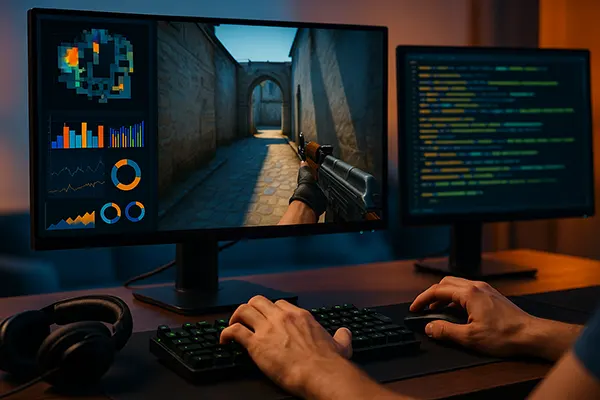Analytical and Statistical Tools in CS:GO — From Basic to Professional Level

In the world of Counter-Strike: Global Offensive (CS:GO), understanding data has become as vital as mastering weapon control. Modern teams rely on in-depth analytics to refine tactics, predict opponents’ behaviour, and make data-driven adjustments during tournaments. By 2025, analytical tools have evolved far beyond simple score tracking — they now offer comprehensive breakdowns of movement, grenade precision, and round economy.
Popular Tools for Analysing CS:GO Performance
One of the most widely used tools today is Scope.gg, which provides a detailed breakdown of player statistics, including kill-to-death ratios, accuracy by weapon type, and even heatmaps of movement across maps. The system analyses demo files directly from official matches, helping both amateurs and professionals understand individual weaknesses and tactical flaws. Another platform, Leetify, uses artificial intelligence to rate player performance compared to professional standards, tracking metrics such as positioning efficiency and decision timing.
Teams also rely on CSGO Demo Manager, an open-source utility that allows users to analyse replays with frame-by-frame precision. Coaches can highlight key mistakes, missed utility throws, or poor rotations. In 2025, integrations between Steam and analytical apps enable automatic upload and categorisation of match data, making review processes faster and more consistent.
For strategic data, FACEIT Insights and HLTV Advanced Stats remain essential. They offer access to professional match databases, allowing analysts to study how top teams adapt their economy and map control based on different opponents. This professional-level insight gives smaller teams a chance to adopt winning strategies backed by real numbers rather than guesswork.
How These Tools Improve Tactical Understanding
Modern analytical tools help players visualise more than just personal mistakes. They reveal hidden tactical layers, such as the frequency of successful retakes, the timing of flashes in key areas, or the efficiency of crossfires. By comparing demo data with professional matches, players can clearly see how high-tier teams execute strategies on maps like Mirage or Inferno.
Coaches increasingly use heatmaps and smoke trajectory tools to teach optimal grenade placement. For example, systems like NadeSight allow full trajectory simulation, helping players perfect complex throws. These precise training insights reduce wasted utility and increase team coordination, which directly translates into better in-game execution.
Furthermore, statistical tracking encourages accountability within teams. Every player can see how their choices impact the economy or round win percentage. By 2025, many esports organisations include analytics staff who specialise in converting this data into actionable tactical recommendations.
How Teams Use Data to Gain Competitive Advantage
Top esports organisations such as Natus Vincere, G2 Esports, and Vitality have integrated analytics departments that work alongside coaches. Their analysts use advanced data models to evaluate player efficiency and simulate potential outcomes before major tournaments. Through video-based pattern recognition, they detect opponent tendencies such as common bombsite hits or default mid-control patterns.
During tournaments, real-time dashboards aggregate player and round statistics, providing immediate feedback between halves. Analysts highlight unusual economy decisions or inconsistent utility usage, enabling rapid strategic corrections. For example, if a team consistently loses anti-eco rounds, the system identifies purchasing trends and suggests resource redistribution.
Even mid-tier teams benefit from freely available tools that replicate professional workflows. Automated scrim reports summarise grenade success rates, team trade ratios, and time-to-engagement metrics. This transparency helps players improve without external coaching, democratising access to professional-level insight.
Data Integration and Machine Learning in CS:GO
Since 2023, machine learning models have significantly improved match prediction accuracy. By 2025, advanced analytics platforms apply neural networks to simulate potential round outcomes based on player positions, past data, and timing patterns. These models not only predict win probability but also highlight the most influential moments during matches.
Several teams use proprietary AI dashboards that merge in-game telemetry with psychological factors, like reaction under pressure and performance consistency. This combination helps identify when a player might underperform during clutch scenarios, allowing teams to adjust support strategies in real-time.
The integration of big data has transformed CS:GO from a mechanical shooter into a deeply analytical sport. The boundaries between human intuition and data-driven coaching continue to blur, setting new standards for esports professionalism.

Emerging Analytical Models with Future Potential
While mainstream analytics focus on statistics, emerging research explores predictive behavioural modelling. This approach uses historical demos to forecast opponents’ next moves with over 70% accuracy. In 2025, universities and independent developers collaborate to refine these algorithms for esports use, testing them in semi-professional tournaments.
Another promising direction is biomechanical tracking. With VR and motion capture becoming more accessible, analysts are studying physical reaction patterns, such as mouse movement smoothness and hand stability. These metrics provide a new understanding of mechanical consistency, potentially revolutionising player evaluation.
Finally, cross-game analytics — integrating data from other shooters like Valorant — help organisations train flexible players. Comparing cognitive decision speed and tactical adaptation across titles allows teams to identify which skills transfer best between competitive environments, further professionalising the analytical side of esports.
The Future of Data in Competitive CS:GO
As Counter-Strike 2 continues to evolve, the future of analytics will likely merge in-game telemetry directly with cloud-based systems. This means that post-match reports could be generated instantly with AI commentary and visual breakdowns. Players will no longer need manual demo reviews — everything will be automated and accessible within seconds.
Professional analysts also anticipate the rise of centralised data marketplaces where teams can exchange anonymised datasets. This collaboration could accelerate tactical evolution and make the competitive scene even more dynamic. However, data privacy and integrity will remain critical concerns that need clear regulation.
Ultimately, the growth of analytics reflects the ongoing professionalisation of esports. In 2025, success in CS:GO is not determined only by reflexes or aim — it’s driven by how effectively teams interpret and apply the numbers behind every round.


